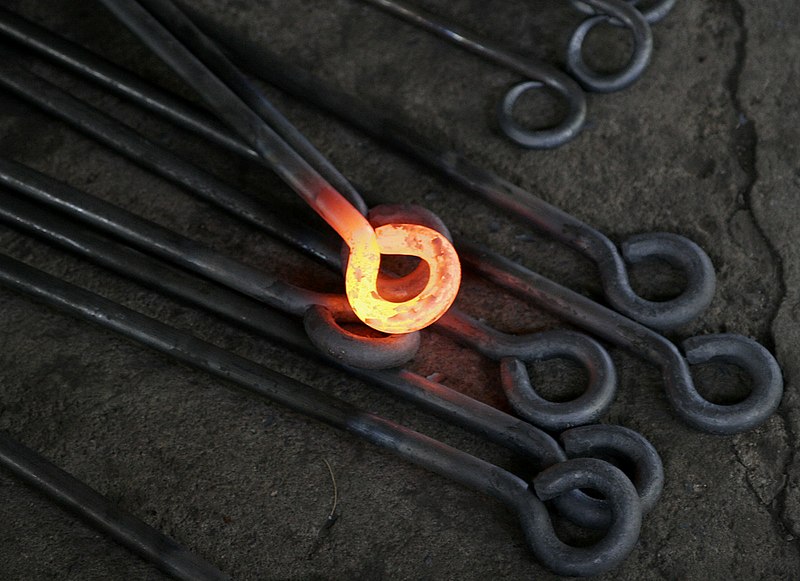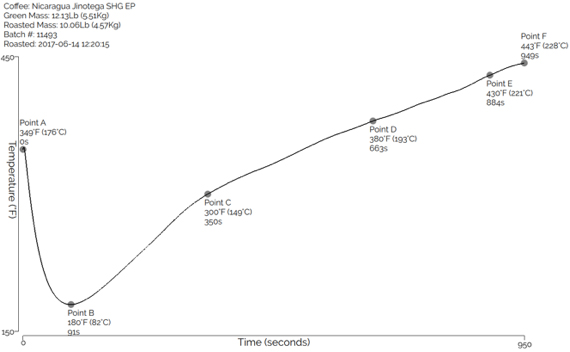
Roasting: Intermediate
#CaffeinatedTraining
#OilSlickCoffee
Presented: November 29th, 2018
Host: 5758 Coffee Lab
Location: Bandung, Indonesia
Press "h" for keyboard shortcuts for this presentation

Heat Transfer
- Thermal Energy
- Heat ≠ Temperature
- Conduction, Convection, Radiation

Conductive Transfer
- Physical contact + temperature gradient
- Common cause of roast defects
- Temperature gradient inside bean
- Water content is critical*

Convective Transfer
- Air as a medium or vehicle
- Most common transfer method in drum and air roasters
- Greater the temp difference between air and bean greater the transfer (potential)

Radiated Transfer
- Electromagnetic radiation (same as the sun)
- Some visible, some not
- Example: light from heat source, heat felt near a heat source
- Metal in roaster acts as a battery, storing energy as heat*

https://upload.wikimedia.org/wikipedia/commons/a/a9/Hot_metalwork.jpg fir0002 | flagstaffotos.com.au [GFDL 1.2 (http://www.gnu.org/licenses/old-licenses/fdl-1.2.html)], from Wikimedia Commons

Heat Transfer, Supplemental
- Drum, Air, Bean
- Air, Drum, Bean
- Bean, Drum, Air
Terry Davis, "The Heat is On, A Roaster's Guide To Heat Transfer," Roast Magazine May/June 2009

Temperature Midway Point ≈ 75 Agtron
- New concept
- Generates easy color to work/train with
- Not meant to be a standard or a sweet spot regarding end product

Calculate TMP


Quick Review
- What are the three types of heat transfer?
- Why is water content important?
- What is the difference between heat and temperature?

The Roasting Cycle
- Evaporation
- Color VS roast curves
- Defects
- Cooling Time

Drying
- Primary concern of first-third of roast (first phase)
- Evaporative cooling

Roasting
- Maillard reaction (complex)
- Streker degradation (complex)
- Melanoidins
- Organic acids
Much more on this tomorrow

Rate of Change
- Often called Rate of Rise (but rate may not always rise)
- Speed (momentum) of the roast
- Typically measured in 30 or 60-second intervals
- Not useful until after TP
- 30s is more accurate than 60s calculations

Rate of Change
Example:
At 4:00 temp is 148°C
At 4:30 temp is 153°C
The temperature increased 5° in thirty seconds
153° - 148° = 5°
Therefore, RoC is 5°/30s
Or if we want a more accurate/higher resolution RoC we could calculate the rate of change per second:
153° - 148° = 5°
Time = 30s
5/30 = .16°/s (not very useful, in my opinion)


Cooling
- Preferably within 4 minutes
- Ideally as fast as possible
- Quenching with water can be bad (but can be done)

Quick Review
- How much mass is typically lost during the roast and what is most of the ‘material’ that is lost?
- Which occurs first (and thus longest); Strecker degradation or the Maillard reactions?
- Why are darker roasts less acidic?

Basic properties and changes
- Coffee is organic!
- Endothermic VS exothermic reactions
Important changes to observe and measure:
- Temperature over time
- Volume
- Weight
- Color
- Density

Activity: Visual ID Roast Stages

Temperature over time
- Temperature evolution
- Typically includes bean and air or environment temp (BT & ET)
- Momentum (Rate of change or rate of rise)

Volume Changes
- Cell walls become brittle
- Water vapor inside bean creates a vapor “wall”*
- CO2 build-up
- Other organic gasses

Weight Changes
- Weight difference is a critical measurement
- Weigh coffee before and after roasting and calculate % weight loss
- Density change is also a good measurement to track consistency

Color changes
- Sugar browning
- Melanoidins
- Industry standards for color measurement

Sugar Changes
- Simple sugars already present in green bean
- Broken down and used later to form polysaccharides
- Caramelization
- Maillard VS Caramelization

Acidity Changes
- Acids created early in roast
- Get reduced later in roast
- Therefore acidity provides information on roast level
More on acids tomorrow!

Workspace Management
Green coffee storage, ideal conditions:
- 60% relative humidity
- Green beans at 10-12% moisture content (12% = longest shelf life with 60% relative humidity)
- Keep bags ~15cm off floor, away from pests, water, etc
- Consider GoPro bags (can be expensive)
- Routinely check and monitor condition of stored greens

Workspace Management
Ideal safety conditions
- Production flow
- Efficiency, organization in layout & movement
- Physical safety/health (heavy lifting)
- Air quality while roasting
- Big roasting machine (20+Kg) consider a mask
- When handling greens consider a mask
- Not just gases, but micro-fibers & micro-particles from greens
- Fire safety
- Fire suppression
- Plan for a roaster fire
- Share the plan with everyone
- Revisit the plan regularly (at least yearly)

Roaster Machine Construction
- Drum roaster
- Fluid bed
- Batch VS continuous roaster

Ventilation
- Within the drum, ventilation creates convection heat transfer
- Keep the exhaust stack clean to avoid fires!
- Ensure dangerous gases are evacuated from facility

Electricity
- Electric roasters are fine for sample roasting or lab roasting.
- Electrical heating elements are slow and don’t scale well
Question: how would you compensate for the lag caused by an electrical heating element?

Tools for roasting
- Buckets + shovel/scoop
- Logging sheets or software
- Timer and temperature probes
- Infrared thermometer can be helpful
- Moisture, density, and roast color meters are handy (and getting cheaper and smaller)
- Quality Control System (what does this look like?) *A roaster (obviously)

Cleaning, Maintenance, & Troubleshooting
- Ventilation ducts
- Chaff collector
- Exhaust air cleaning
- Cooling tray
- Area surrounding roaster

Tomorrow
We’ll meet in the cupping lab
We’re cupping immediately after a quick meeting
- No perfumes, colognes or heavy fragrances
- Be done smoking in time for your clothes to air-out

Roasting Activity: 5 Roasts
Roast 1: Perform roast with any profile to Temperature Midway Point (sample color creation).
Roast 2: Perform roast with similar profile to Midway Point of Roast 1 but continue to the start of 2nd Crack (and thereby resulting in a longer development time).
Roast 3: Roast coffee to the same profile to First Crack, then end at the same color with a longer development time (over 4 mins).
Roast 4: Roast coffee to the same profile to First Crack, then end at the same color with a shorter development time (under 1:30).
Roast 5: Roast coffee to the same profile to First Crack, then end at the same color with a 2-3 minute development time.
Value 4 Value
If you found this content useful, please consider supporting my work. I charge no set fee or price for providing this. You can help keep information like this openly accessible by matching the value you received in the content; value 4 value.
Ko-fi / Bitcoin Wallet: 32SW9kcAsJdZvQKBazhLUZBSD9YS8DDqe8

End of presentation